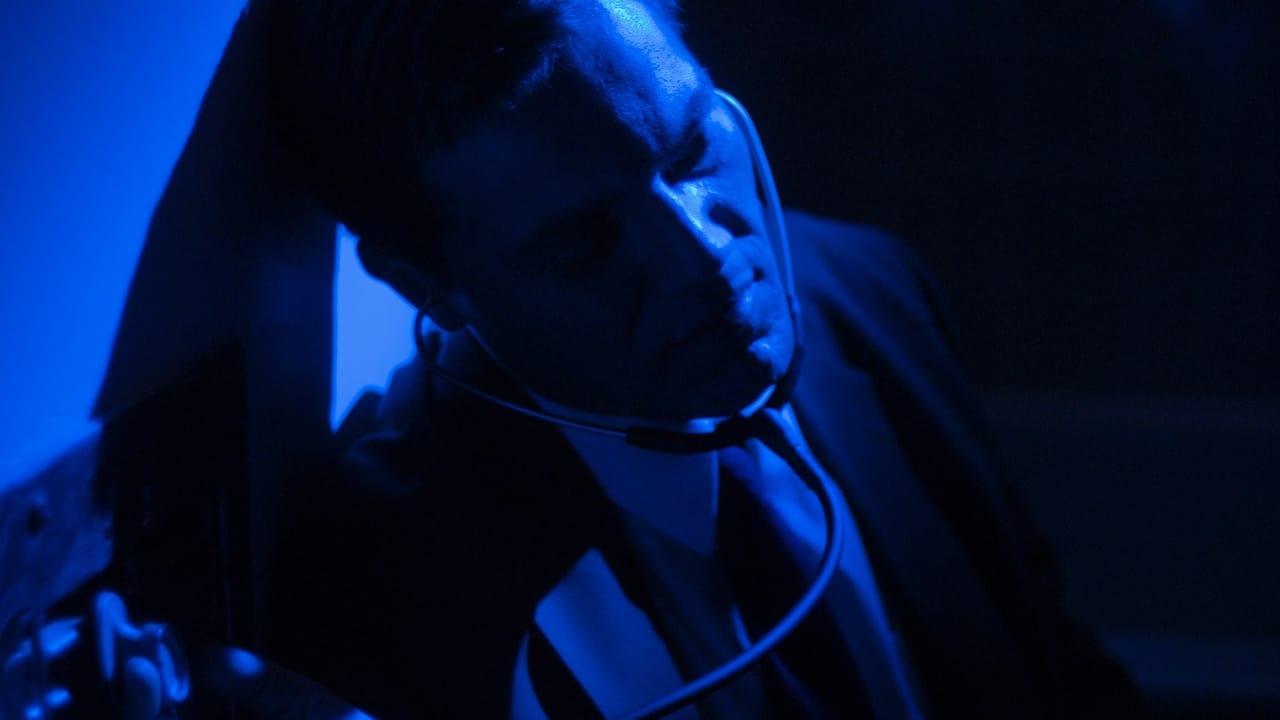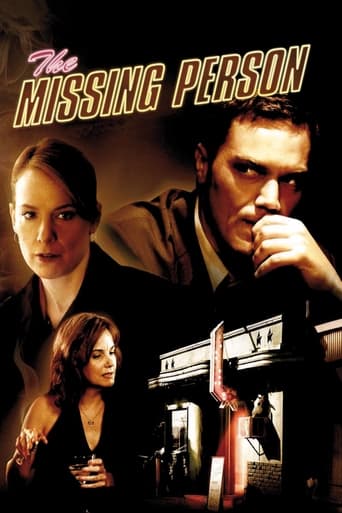

Terrible acting, screenplay and direction.
... View Morean ambitious but ultimately ineffective debut endeavor.
... View MoreThe plot isn't so bad, but the pace of storytelling is too slow which makes people bored. Certain moments are so obvious and unnecessary for the main plot. I would've fast-forwarded those moments if it was an online streaming. The ending looks like implying a sequel, not sure if this movie will get one
... View MoreThis movie tries so hard to be funny, yet it falls flat every time. Just another example of recycled ideas repackaged with women in an attempt to appeal to a certain audience.
... View MoreMichael Shannon has a face built for noir, but writer/director Noah Buschel doesn't exploit it well enough in "The Missing Person". The film's a neo-noir, but slack pacing, amateurish dialogue, unnecessary nods to 9/11 and a low budget hamper things.Still, the overall arc of Bushchel's screenplay is very interesting. It stars Shannon as John Rosow, a hard-drinking, hard-boiled (is there any other?) private investigator who's tasked with trailing a man named John Fullmer. Here's the interesting part: Rosow learns that Fullmer has been both a "missing person" and presumed dead for many years. Though Rosow is tasked with "bringing in" Fullmer so that he may be reunited with his family, he opts against it. Better to let Fullmer live peacefully in his newly fabricated life. This reprieve echoes Rosow's own private demons, which he too must "let go of" if he hopes to "build a new life". The film suggests that Roscow's evocative of ancient noir gum-shoes precisely because he is always caught "out of time", locked into dwelling about a past that he can't let go of and so keeps on scarring.The film contains several visual allusions to and recreations of Edward Hopper's "New York Movie", an oil-on-canvas painting from 1939. Why Hopper? Hopper's proved a huge influence on noir. His "Nighthawks" was cooked up after reading Ernest Hemingway's noirish "The Killers" (the filmed version of Hemingway's tale would later be influenced by Hopper's paintings), but even two decades before this, long before noir was even born, Hopper was churning out moody paintings evocative of early noirs. His 1921 etching "Night Shadows", for example, looks like an ahead-of-its-time high-angle shot from a Fritz Lang movie and his "House by the Railside" (and numerous early paintings of anonymous apartment blocks and motels) would prove a huge influence on Hitchcock's "Psycho". Walter Hill ("The Driver", "Hard Times") and Wim Wenders ("Hammet", "Paris Texas", "The American Friend", "The End of Violence") would openly consult Hopper's work when filming the aforementioned films.So Bushchel's nod to Hopper is no surprise. What's surprising is his choice of "New York Movie". This particular painting consists of a movie usherette (blonde, bosomy; a typical noir gal) leaning against a cinema wall. The painting is then split roughly in half such that its left side is bathed in a darkness which offers only glimpses of audience members and a murky cinema screen, upon which escapist, idyllic rolling hills are projected. Meanwhile, the painting's right half serves as the usherette's own mind-space, well-lit, with passionate red curtains, lamps and a mysterious staircase suggestive of her "thoughts up there". Despite - as is traditional of Hopper - strong feelings of anonymity, loneliness, tranquillity and isolation, you sense a whirlpool of thoughts emanating from the usherette. Significantly, the painting is bisected by a phallic pillar, filled with swirling patterns evocative of nightmarish, half-coalesced thoughts. The pillar almost seems to signify the dividing point where fantasy is either (or bleeds into) projected and externalised (the cinema screen/object) or internalised/contemplated (usherette/subject). Rosow seems caught in a similar dilemma, brooding like the usherette instead of letting go like Hopper's eye-ball zapped audience.The film's narrative is a loose retelling of "The Flitcraft Parable", a moment of digression in Dashiell Hammett's noir novel "The Maltest Falcon". One of literature's great digressions, the parable involves detective Sam Spade telling a girl the story of a middle class real estate agent called Flitcraft who, after nearly dying, has an existential epiphany. Flitcraft then decides to abandon his wife, kids, large income and perfect American family. "He went just like that," Spade says, "like a fist when you open your hand." The irony is that Spade then stumbles upon Flitcraft several years later living a "new life" almost identical to his "old one". Having wiped the slate clean, Flintcraft thus inadvertently rebuilt that which he was running away from. Men, Spade implies, adjust themselves to the world. Spade, however, adjusts the world to himself. This, of course, is a very Satrean, existential commitment. Bushchel's retelling of the parable doesn't go this far.7.5/10 – Worth one viewing. See "Black Dahlia", "The Big Sleep" and "A Prairie Home Companion".
... View MoreIn "The Missing Person," Michael Shannon goes the Bogart route, playing a cynical, booze-soaked private detective who's hoping to find a little redemption in his latest assignment, trailing a man he knows little to nothing about – not even his name. But before long, John discovers that there's much more to this man than meets the eye, and that the two of them are strangely linked to one another through the tragedy of 9/11. In a way, each of them is a "missing person," one in a literal and one in a figurative sense. Indeed, the best thing about "The Missing Person" is that just as you think the movie is about one thing, it turns out to be about something else altogether.This moody, bluesy, boozy movie, written and directed by Noah Buschel and co-starring Amy Adams, is deliberate in its pacing and borderline pretentious in style, with characters who speak in clipped phrases, uttering half-articulated thoughts and hardboiled wisecracks as the details of the story spin themselves out. It may not be for every taste, but the movie hauntingly captures the different but equally intense responses people can have to trauma and loss.
... View MoreI had the pleasure of seeing this movie at the Edinburgh Film Festival. While I do not think it will be very popular, for those who like movies that are a little unusual, this one is for you. The pacing, the music, the lighting is all unusual and terrific. The director Noah Buschel spoke after the film and said he was trying to make a noir where everything happened in very ordinary, everyday ways. A "boring noir" is what he called it. In other words, the movie is so low-key that it becomes almost a different genre than noir.But the movie is by no means some kind of abstract experiment. It had me crying hard at the end of the movie. The credit goes to Buschel and Michael Shannon. Shannon breaks through to another level in this movie, adding a sweetness that I hadn't seen in him before.Heartbreaking stuff.
... View MoreAfter seeing "Neal Cassady" at the Woodstock Film Festival last year, I was interested to see what young director Noah Buschel would do with the noir genre. I was not disappointed.Like his beat "biopic," Buschel turns the genre right on it's head and makes something completely fresh and new. "The Missing Person" has very little to do with it's surface elements, and much more to do with innovative and original film-making.Michael Shannon delivers his best performance to date. It's him in full movie star wattage. He looks great, he sounds great, and he makes a great damaged hero. The rest of the cast is so superb you almost wish there was more of them in the film.Perhaps the best use of jazz music I've heard in a film.There will be those who want a faster paced movie. More violence and quickness and loudness. They should just watch "Brick." That was a good example of a shallow neo-noir. This is not "Brick." This is a deep and unique film about loss. And also, somehow, a hilarious film about loss.Geoffrey Gilmore, the festival director, introduced "The Missing Person" the night I saw it at Sundance. He said that it was the first film accepted at Sundance this year and that Buschel was doing something no one else was doing right now, which was going back to old forms and making them new again. A lost art, he said. Something that 70's directors used to do a lot.The key point he made was that "The Missing Person" was an utterly unique film in the guise of a noir film. I couldn't agree more.
... View More